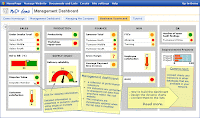These days most people know what a balanced scoredcard is. The challenge is understanding the benefits of a balanced scorecard to your organisation. Following on from a previous post Business Intelligence - Scorecards and Dashboards I discuss 6 key reasons to implement a Balanced Scorecard.
Definition: The balanced scorecard is a strategic planning and management system that is used extensively in business and industry, government, and nonprofit organisations worldwide to align business activities to the vision and strategy of the organization, improve internal and external communications, and monitor organisation performance against strategic goals.
This Balance Scorecard was designed using Sharepoint by enterprise Dashboard.
- Increase focus on strategy and results
- Improve organisational performance by measuring what is important
- Prioritise Projects & Initiatives
- Align organisation strategy with daily operational tasks
- Focus on the drivers of future performance
- Effectively communicate your Vision and Strategy
1. Increase focus on strategy and results
Implementing a balanaced score card requires your team to analyse the internal business processes. Metrics based on these findings allow managers to know how well their business is running, and whether its products and services conform to the strategy and mission.
2. Improve organisational performance by measuring what is important
What is important is defined by what is in the strategy and KPIs extracted from this strategy. By articulating these KPIs and measuring what is important via key metrics - this will improve a organisations performance.
3. Prioritise Projects & Initiatives
Once the each KPI metric is defined the projects required to achieve either the measurement or implementation to achieve strategic objects become more important. Although this is a very simplistic approach to determine what initatives are important - it does provide a basis for prioritising projects.
4. Align organisation strategy with daily operational tasks
In order for an organisation to achieve its strategic goals, daily operational tasks must be aligned to at least one of the strategies KPIs. The daily operational tasks will provide metrics that can be rolled up to provide Business Activity Monitoring. The investigation process will often reveal many daily operational tasks that you can not answer the following questions:
- Why do we perform this task?
- How does this task contribute to any of the strategic goals?
5. Focus on the drivers of future performance
Identifying what your future performance drivers are, will provide you with a focus of what activities are important to your organisation. Focusing on what metrics are required to measure the success of your performance drivers will provide you with the start of a roadmap.
6. Effectively communicate your Vision and Strategy
The balanced scorecard transforms an organisation’s strategic plan from an attractive but passive document into the marching orders for the organisation on a daily basis. It provides a framework that not only provides performance measurements, but helps planners identify what should be done and measured. The implementation of the vision and strategy help to communicate what is truly required in daily operational tasks to achieve one or more of the strategies KPIs. Communicating how a strategy relates to daily operational tasks with all staff both executive and operational will help disemeninate the vision.
These six reasons articulate how a Balanced Scorecard enables executives to truly execute their strategies.

Kaplan and Norton (the architects of the Balanced Scorecard) describe the development of the balanced scorecard as:
"The balanced scorecard retains traditional financial measures. But financial measures tell the story of past events, an adequate story for industrial age companies for which investments in long-term capabilities and customer relationships were not critical for success. These financial measures are inadequate, however, for guiding and evaluating the journey that information age companies must make to create future value through investment in customers, suppliers, employees, processes, technology, and innovation."






